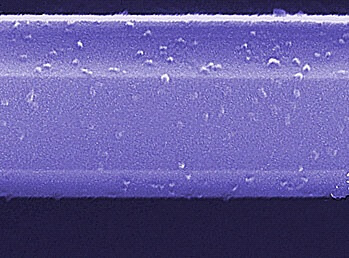The sensor developed by the team of researchers from the American National Institute of Standards and Technology detects harmful pollutants emitted from paints, dry cleaning materials, pest exterminators and other products - which provide several advantages compared to commercial gas sensors that exist today

A team of researchers from the National Institute of Standards and Technology, and two other US universities, developed nanometer sensors capable of detecting volatile organic compounds - harmful pollutants emitted from paints, dry cleaning agents, pest exterminators and other products - which provide several advantages compared to commercial gas sensors that exist today, including the ability to operate them At room temperature and with low energy consumption, as well as the ability to detect one or more compounds in a variety of concentrations.
The research, recently published, is a "proof of concept" for a gas sensor consisting of a single nanowire and metal oxide nanoclusters designed to react with a certain organic compound. This research is the latest attempt out of several efforts made at the institute (NIST) that utilize the unique properties of nanowires and metal oxide components to detect dangerous substances.
Current commercial gas sensors contain thin electrically conductive layers composed of metal oxides. When a volatile organic compound, such as benzene, reacts with the material titanium dioxide, for example, a chemical reaction changes the current passing through the layer, initiating an audible alarm. Although most sensors based on thin films are indeed effective, they must be operated at a temperature of 200°C or higher. However, frequent heating can break down the materials that make up the layers and connections, a feature that causes reliability problems. In addition, most sensors based on thin layers operate in a narrow range: a small amount of a volatile substance, such as toluene, can be detected, but the sensor will not be able to do so if a large amount of the substance has been released into the air. The range of activity of the new sensors extends from 50 parts per million to XNUMX part per hundred, i.e. XNUMX percent, of the air in the room.
The new sensors, produced using the same production processes used today to make computer chips from solder, operate according to the same principle, but on a much smaller scale: the wires of the gallium nitride material are less than 500 nanometers thick and less than ten micrometers long. Despite their microscopic size, the titanium dioxide nanowires and nanoaggregates used in their coating have a high surface-to-volume ratio that gives them exceptional sensitivity.
"The electric current passing through our nanosensors is in the range of microamperes, while normal sensors require milliamperes, so we operate them using less energy and electricity" explains one of the researchers. The innovative nanosensors also offer higher reliability and a smaller size. They are so tiny that they can be placed anywhere. To activate the titanium dioxide to react in the presence of a volatile organic compound, we use ultraviolet radiation instead of heat. Moreover, each of the wires is a flawless single crystal, instead of a collection of crystal nuclei in normal sensors, so they are less susceptible to discharge. During reliability tests conducted last year, no failures were observed in the innovative nanosensor.
